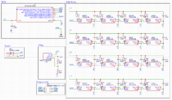A_Wild_Noodle
New Member
Hello all, this is one of my first electronic schematics and I'm trying to make sure everything looks good (electrically) before I order board and components. Another set of eyes on this to criticize and give constructive feedback would be great and point out any issues or mistakes my circuit may have! I think its easy enough to tell when this is, its a stand alone RGB LED array with its on little MCU. The purpose is to use an Arduino to use as a programmer for the on board ATTiny MCU so it can operate and loop through an animation where the only external connection is to power from a 5v DC supply. I think if anything the MISO MOSI lines are going to have to be revised. Attached are the datasheets for the LED's and the MCU as well as a screen shot of the schematic.


